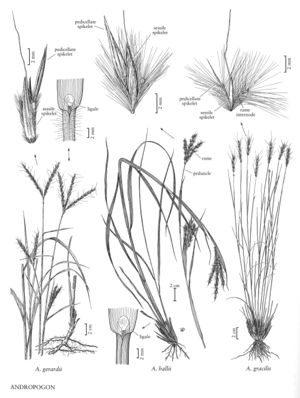Andropogon gerardii
Plants often forming large clumps, rhizomes, if present, with internodes shorter than 2 cm. Culms 1-3 m, often glaucous. Sheaths glabrous or pilose; ligules 0.4-2.5 mm; blades 5-50 cm long, (2)5-10 mm wide, usually pilose adaxially, at least near the collar. Inflorescence units usually only terminal; peduncles with 2-6(10) rames; rames 5-11 cm, exserted at maturity, usually purplish, sometimes yellowish; internodes sparsely to densely pubescent, hairs 2.2-4.2 mm, usually white, rarely yellowish. Sessile spikelets 5-11 mm, scabrous; awns 8-25 mm; anthers 3, 2.5-4.5 mm. Pedicellate spikelets 3.5-12 mm, usually well-developed and staminate. 2n = 20, 40, 60 (usually), 70, 80.
Distribution
Conn., N.J., N.Y., Wis., Del., D.C., Man., Ont., Que., Sask., W.Va., Colo., Fla., Wyo., N.H., N.Mex., Tex., La., Tenn., N.C., S.C., Pa., Va., Mass., Maine, R.I., Vt., Kans., N.Dak., Nebr., Okla., Ala., Ark., Ill., Ga., Ind., Iowa, Ariz., Md., Ohio, Utah, Mo., Minn., Mich., Mont., Miss., Ky., S.Dak.
Discussion
Andropogon gerardii grows in prairies, meadows, and generally dry soils. It is a widespread species, extending from southern Canada to Mexico, and was once dominant over much of its range. It is frequently planted for erosion control, restoration, or as an ornamental; the records from Washington and central Montana reflect such plantings. It hybridizes with A. ballii, the two sometimes being treated as conspecific subspecies.
Selected References
None.
